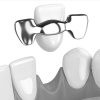Cosmetic Bridges
A dental bridge is the device used to fill a gap created by one or missing teeth. They consist of two or more crowns for the teeth on either side of the gap, which are called the abutment teeth. These teeth will be used as anchors for the false tooth or teeth in between them. These false teeth are called pontics and can be made from gold, alloys, porcelain, or a combination of these materials. They can be supported by natural teeth as well as implants.
What Are the Benefits of Dental Bridges? 
These are the primary advantages your Springfield dentist will inform you of:
- They restore your smile
- Restore the ability to properly chew and speak
- Maintain the shape of your face
- Distribute the forces in your bite properly by replacing missing teeth
- Prevent remaining teeth from drifting out of position
What Types of Dental Bridges Are Available?
The main types consist of:
- Traditional bridges. This is when a crown is created for the tooth or implant on either side of the missing tooth. They are the most common and usually made of porcelain fused to metal or ceramics
- Cantilever bridges. This is when there are adjacent teeth on only side of the gap. They are now only used infrequently and are not recommended for the rear of the mouth where they can place too much force on other teeth and damage them.
- Maryland bonded bridges. These are also referred to as a resin-bonded bridge or a Maryland bridge and are made of porcelain, porcelain fused to metal, or plastic teeth and gums supported by a metal or porcelain framework. Metal or porcelain wings on each side of the bridge are bonded to the existing teeth.
What is Involved with Receiving Dental Bridges?
In your first visit to your Springfield dentist, the adjacent teeth are prepared by recontouring. This is simply removing a portion of the enamel to have enough room for the crown to be placed over them. Then impressions are taken of the teeth which serve as the model for how the lab will make the bridge. The first device while be temporary.
In the second visit, the permanent device will be checked for fit and adjusted if necessary. There may be several other visits to your Springfield dentist to make sure your bite is correct and no problems are present. After several weeks it will be cemented in place.



